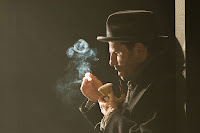The books that make you go ooooooooo!!!!
Venue: Outlaws Yacht Club
Date: Inagural meeting on 28th of May, thereafter the last Thursday of each month
Time: 6pm for a 6:30 start
THE HOUND OF THE BASKERVILLES
ARTHUR CONAN DOYLE
* * * SPOILERS * * *
Our first meeting of #LBCOutlaws involved a brief introduction to the book club and what it was about and involved lots of tea and cake.
Information about the author
Sir Arthur Conan Doyle was born in Edinburgh on May 22, 1859, one of seven children who survived to adulthood. Rejecting his family's strict Catholicism and, cut off from their patronage, he decided to set up his own practice in Southsea in 1882.After the death of his first wife, Louise Hawkins, he went on to marry Jean Leckie in 1907 and they had two sons and a daughter. He died in 1930.The Hound of the Baskervilles is one of the four crime novels by Sir Arthur Conan Doyle featuring the detective Sherlock Holmes. Originally serialised in the Strand Magazine from August 1901 to April 1902, it is set largely on Dartmoor in Devon in England's West Country and tells the story of an attempted murder inspired by the legend of a fearsome, diabolical hound.
Heed the Baskerville family legend of the hound: avoid the moors in those hours of the night when the powers of evil are exalted. Every Baskerville that has lived in the family home since the legend began has met with a violent death. Dr. Mortimer writes to the one man that can help him, Sherlock Holmes, to exorcise the 'Legend of the Hound' that plagues the Baskervilles.
The Hound of The Baskervilles is a well know story told in the first person by Dr Watson from letters and diaries. This was the first appearance of Holmes since his intended death in "The Final Problem" and the success of The Hound of the Baskervilles led to the character's eventual revival.
“The world is full of obvious things which nobody by any chance ever observes.” Holmes
The scene is set in London where we meet Watson and Holmes, news arrives about the family named Baskervilles and the curse that hangs over them. Holmes sends Watson off to Devonshire, which we all felt like it was set in the Yorkshire moors, mainly because we’re all Leeds based but this did not affect the story one bit. It was still eerie and gripped us to our seats.
We all know that the main character is Holmes who sets about solving all these mysteries but rarely do we see past this character and see the characters/people behind him. This story is told by Watson and through this it felt like we saw both him and Holmes in a completely different light. In this story most of us fell in love with Watson and thought he was fabulous and wondered where Holmes would be without him. Holmes came across as arrogant and always succeeds in getting the job done by swooping in at the end and solving the mystery, but will always need Watson to help him do that.
Watson may come across at other times as a bumbling idiot but he has his own career and in most stories as like this one he does most of the legwork, like most characters in this story for Holmes and basically feeds his ego. This is why we love Watson in this story. He is annoyed at being duped and lets Sherlock know this.
“Certainly, though I cannot guarantee that I carry all the facts in my mind. Intense mental concentration has a curious way of blotting out what has passed”
It was a lovely short book, it captured our imaginations. It had a gothic feel full of drama suspense, mystery, a classic. It was said that as it had been serialized it felt sometimes it did not work as a novel; it should have been longer but was different to read as it had more of a supernatural feel rather than a detective story.
The Sherlock Holmes stories have been told in some many different ways starting with books going into plays and films and TV serials. Everyone had their own personal favourites from Jeremy Brett to Benedict Cumberbatch. But all were agreed the book was better than any film adaption as certain parts were meant to keep you guessing or believing something had happened whereas the TV/film adaption had to show you it happened to prove it did.
All in all the first read for Outlaws bookclub was loved and adored and many would read more of Sherlock’s Adventures.
We also recommend seeing Sherlock’s Secrets at the West Yorkshire
Playhouse which I've blogged about HERE and LBC has reviewed HERE!
Score
8/10
Join in the chat on twitter #LBCOutlaws or chat with @Pixlz or @LeedsBookClub.
Follow Helen @IsFromUpNorth
Project Gutenberg and Kindle: HERE
Book Club - Table of Contents
* * * * *






















































